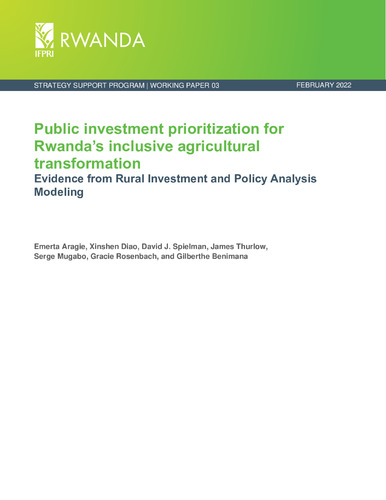Public investment prioritization for Rwanda’s inclusive agricultural transformation: Evidence from rural investment and policy analysis modeling
Abstract
As Rwanda is expected to return to its rapid growth trajectory following the COVID-19 pandemic, agriculture will continue to play a central role in the structural transformation of the entire economy. To this end, the Government of Rwanda continues to invest in the agricultural sector by building on Strategic Plans for the Transformation of Agriculture (PSTAs) that began in the early 2000s. The challenging question is how to prioritize public expenditures across a broad portfolio of policies and programs. Ambitious plans, whether in the short or long term, require difficult decisions. The prioritization of public investment becomes even more complex as Rwanda’s structural transformation advances and as new investments—beyond the farm—become critically important for the agricultural sector. The structural transformation process itself means that as agriculture becomes more integrated with the rest of the economy, public resource allocations need to address a wider range of issues across the entire food system; these include nutrition-sensitive food production systems, inclusive value chain development, nonfarm rural enterprise development, and climate-resilient sustainable intensification of both crops and livestock.
This study provides evidence that is designed to assist the Government of Rwanda in its selection of agricultural policy, investment, and expenditure portfolios that reflect the country’s broad focus on its food system and structural transformation. This process of prioritization will need to incorporate multiple public investments targeting multiple development outcomes and will need to be grounded in the costeffective use of public resources in a largely market-led transformation process. This data-driven and evidence-based approach must critically underpin an informed investment prioritization process that helps achieve ambitious targets in an environment constrained by limited public resources. The study uses the Rural Investment and Policy Analysis (RIAPA) economywide model developed by the International Food Policy Research Institute (IFPRI), with contributions from colleagues at the Ministry of Agriculture and Animal Resources (MINAGRI), the Ministry of Finance and Economic Planning (MINECOFIN) and the National Institute of Statistics of Rwanda (NISR). The study draws on data from multiple sources as well as expert insights to inform the application of RIAPA’s Agricultural Investment for Data Analyzer (AIDA) module as a tool to measure the impacts of alternative public expenditure options on multiple development outcomes. Using this integrated modeling framework, the study links agricultural and rural development spending to four specific outcomes: economic growth, job creation, poverty reduction, and diet quality improvement; at the same time, it considers the synergies and tradeoffs associated with the different investment options in the transformation process.
The paper first assesses the contribution of public expenditures to agricultural and rural development under the fourth Strategic Plan for Agriculture Transformation (PSTA 4) that extends between 2018 and 2024. These findings are important, given the fact that since the beginning of PSTA 4, the budget allocated to MINAGRI (measured in constant prices) has stagnated. Our results suggest that increased spending on agriculture is well justified and that such spending is essential if the Government of Rwanda is to achieve its long-term development goals.

